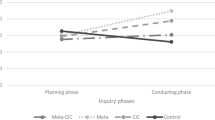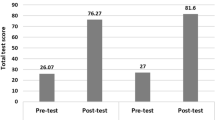Abstract
This study addressed computer-supported collaborative scientific inquiries in remote networked schools (Quebec, Canada). Three dyads of Grade 5–6 classrooms from remote locations across the province collaborated using the knowledge-building tool Knowledge Forum. Customized scaffold supports embedded in the online tool were used to support student understanding and practice of an authentic inquiry process. The research studied how the use of the scaffolds could help students to understand and put into practice an authentic inquiry process. Students created notes and used the scaffolds to support their inquiry process; however, without sufficient direct teacher modeling, coherent use of the scaffolds stayed low across activities. Pre- and posttest results show that the students gained a better understanding of the inquiry process, but low posttest scores suggest further need for direct teacher modeling of the inquiry process during science instruction.
Résumé
Cette étude concerne les enquêtes scientifiques collaboratives assistées par ordinateur dans les écoles éloignées en réseau (Québec, Canada). Trois dyades de classes de 5e et 6e années situées dans des endroits éloignés de la province ont travaillé ensemble par l’intermédiaire de l’outil d’élaboration de connaissances Knowledge Forum. Des supports d’échafaudages personnalisés intégrés dans l’outil en ligne ont favorisé la compréhension des élèves et la pratique d’un processus authentique d’étude. L’étude se penche sur la manière dont ces échafaudages peuvent aider les élèves à comprendre et à mettre en pratique un processus d’enquête authentique. Les élèves ont créé des notes et utilisé les échafaudages pour faciliter leur processus d’enquête. Toutefois, sans une modélisation pédagogique directe suffisante, le niveau d’utilisation cohérente de ces structures est demeuré faible au cours des activités. Les résultats des tests préliminaires et postérieurs démontrent que les élèves ont acquis une meilleure compréhension du processus d’enquête, mais les faibles résultats aux tests finaux indiquent qu’il est indispensable d’augmenter la modélisation pédagogique directe lors de la phase scientifique.
Similar content being viewed by others
References
Allaire, S. (2006). Les afordances socionumériques d’un environnement d’apprentissage hybride en soutien à des stagiaires en enseignement secondaire: De l’analyse réfexive à la coélaboration de connaissances [Socionumériques afordances in a blended learning environment to support preservice teachers in secondary education: From the refexive analysis to knowledge building] (Unpublished doctoral thesis). Université Laval, Canada.
American Association for the Advancement of Science. (1994). Benchmarks for science literacy. New York, NY: Oxford University Press.
Bereiter, C., & Scardamalia, M. (2005). Technology and literacies: From print literacy to dialogic literacy. In N. Bascia, A. Cumming, A. Datnow, K. Leithwood, & D. Livingstone (Eds.), International handbook of educational policy (pp. 749–761). Dordrecht, The Netherlands: Springer.
Brown, J. S., Collins, A., & Duguid, P. (1989). Situated cognition and the culture of learning. Educational Researcher, 18(1), 32–42.
Bruner, J. (1960). The process of education. Cambridge, MA: Harvard University Press.
Bruner, J. (1983). Le développement de l’enfant. Savoir faire, Savoir dire [Child’s talk: Learning to use language]. Paris, France: PUF.
Burtis, J. (2001). The Analytic Toolkit for Knowledge Forum. Toronto, ON, Canada: Knowledge Forum Project, Ontario Institute for Studies in Education/University of Toronto. Retrieved from http://kftools.oise.utoronto.ca/atk/
Chan, C. K. K., Lam, Y. C. K., & van Aalst, J. (2003, April). Social-constructivist assessment, knowledge building discourse, and conceptual understanding. Paper presented at the AERA, Chicago, IL.
Clancey, W. J. (1995). A tutorial on situated learning. In J. Self (Ed.), Proceedings of the International Conference on Computers and Education (pp. 49–70). Charlottesville, VA: Association for the Advancement of Computing in Education (AACE).
Collins, A., Brown, J. S., & Newman, S. E. (1989). Cognitive apprenticeship: Teaching the craft of reading, writing, and mathematics. In L. B. Resnick (Ed.), Knowing, learning, and instruction: Essays in honor of Robert Glaser (pp. 453–494). Hillsdale, NJ: Erlbaum.
Etheris, A. I., & Tan, S. C. (2004). Computer-supported collaborative problem solving and anchored instruction in a mathematics classroom: An exploratory study. International Journal of Learning Technology, 1(1), 16–39.
Hakkarainen, K. (2003). Emergence of progressive-inquiry culture in computer-supported collaborative learning. Learning Environments Research, 6, 199–220.
Hamel, C., Turcotte, S., & Laferrière, T. (2013). Evolution of the conditions for successful innovation in remote networked schools. International Education Studies, 6(3), 1–14. doi:10.5539/ies.v6n3p1
Laferrière, T., Hamel, C., Allaire, S., Turcotte, S., Breuleux, A., Beaudoin, J., & Gaudreault-Perron, J. (2011). L’ É c o l e éloignée en réseau (ÉÉR), un modèle [Remote networked schools: A model]. Québec, QC, Canada: Centre francophone d’informatisation des organisations (CEFRIO).
Laferrière, T., Hamel, C., & Searson, M. (2013). Barriers to successful implementation of technology integration in educational settings: A case study. Journal of Computer Assisted Learning, 29(5), 463–473. doi:10.1111/jcal.12034
Lave, J., & Wenger, E. (1991). Situated learning: Legitimate peripheral participation. Cambridge, UK: Cambridge University Press.
Lee, E. Y. C., Chan, C. K. K., & Aalst, J. (2006). Students assessing their own collaborative knowledge building. International Journal of Computer-Supported Collaborative Learning, 1(2), 277–307. doi:10.1007/s11412-006–8997-6
Miles, M. B., & Huberman, A. M. (1994). Qualitative data analysis (2nd ed.). Newbury Park, CA: Sage.
National Research Council. (1996). National science education standards. Washington, DC: National Academy Press.
National Research Council. (2000). Educating teachers of science, mathematics and technology: New practices for the new millennium. Washington, DC: National Academy Press.
National Research Council. (2011). A framework for K–12 science education: Practices, crosscutting concepts, and core ideas. Washington, DC: National Academy Press.
Palincsar, A. S., & Herrenkohl, L. R. (2002). Designing collaborative learning contexts. Theory Into Practice, 41(1), 26–32.
Pea, R. D. (2004). The social and technological dimensions of scafolding and related theoretical concepts for learning, education, and human activity. Journal of the Learning Sciences, 13(3), 423–451.
Scardamalia, M. (2004). CSILE/Knowledge Forum. In Educational technology: An encyclopedia. Santa Barbara, CA: ABC-CLIO.
Scardamalia, M., Bereiter, C., & Lamon, M. (1994). The CSILE project: Trying to bring the classroom into world 3. In K. McGilly (Ed.), Classroom lessons: Integrating cognitive theory and classroom practice (pp. 201–228). Cambridge, MA: MIT Press.
Turcotte, S. (2008). Computer-supported collaborative inquiry in remote networked schools (Unpublished doctoral thesis). McGill University, Montreal, Canada.
Turcotte, S. (2012). Computer-supported collaborative inquiry on buoyancy: A discourse analysis supporting the “pieces” position on conceptual change. Journal of Science Education and Technology, 21(6), 808–825.
Turcotte, S., Laferrière, T., Hamel, C., & Breuleux, A. (2009). Multilevel innovation in remote networked schools. Systemic Practice and Action Research, 23(4), 285–299. doi:10.1007/s11213-009–9160-x
Zhang, J., Scardamalia, M., Lamon, M., Messina, R., & Reeve, R. (2006). Socio-cognitive dynamics of knowledge building in the work of 9- and 10-year-olds. Educational Technology Research and Development, 55(2), 117–145. doi:10.1007/s11423-006–9019-0
Author information
Authors and Affiliations
Corresponding author
Rights and permissions
About this article
Cite this article
Turcotte, S., Hamel, C. Using Scaffold Supports to Improve Student Practice and Understanding of an Authentic Inquiry Process in Science. Can J Sci Math Techn 16, 77–91 (2016). https://doi.org/10.1080/14926156.2015.1093199
Published:
Issue Date:
DOI: https://doi.org/10.1080/14926156.2015.1093199




